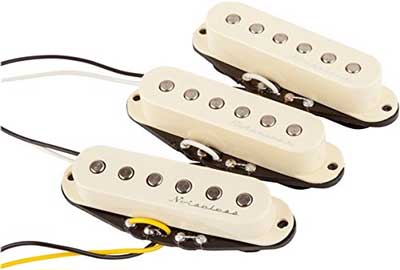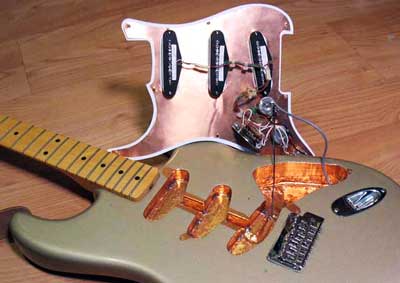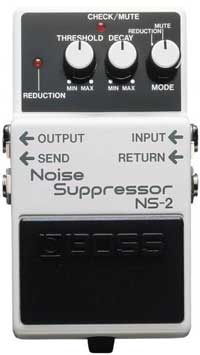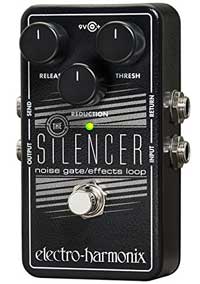There’s nothing that ruins your guitar tone more than hum, buzz or noise. Guitar hum can ruin recordings and be a real pain when performing live. In this guide let’s look at some common questions guitarists have about hum and how to deal with it.
There are a few different causes of hum or noise so your first step is to figure out what type of issue you’re dealing with. Read through the different questions to figure out which one applies to you, then read through the suggested solutions to help get rid of that annoying hum or buzz.
If you want to change your pickups to improve your tone, check out this guide for a step-by-step tutorial on how to upgrade your pickups.
Type of Guitar Hum, Buzz or Noise
The type of noise you’re hearing can help you figure out what the cause is. Let’s look at the three most common types of noise and what they mean to you:
Mains Hum (50 or 60 cycle hum)
This is the most common type of hum you hear in electric guitars. All the wiring in your home or venue emits an electromagnetic field that can impact your guitar’s signal. In the US electricity alternates at 60Hz (50Hz outside of the US) which is why this type of hum is usually called ’60 cycle’ hum.
If you’re in the US, listen to this clip of a 60Hz signal:
If you’re outside of the US, listen to this clip for an example of a 50Hz signal:
If the pitch of your hum sounds similar to one of the above clip, that’s a sign that it’s a mains hum issue. Even if the noise sounds different (eg: it might be more buzzy), if the pitch is the same as one of the above clips, that’s mains hum in action.
Dealing With Mains Hum
As mentioned earlier, mains hum is the result of all the wiring in your home creating an electromagnetic field. This means the hum you hear depends on what’s in your home. Dealing with this hum means figuring out what devices or wiring is causing the issue.
For example fluorescent lights can cause a lot of hum. If you have fluorescent lighting in your room, try turning the lights off and listen if it changes the amount of hum you hear. If it does make a difference, you know that’s part of the issue.
Another way you can figure out what is causing hum is to pick your guitar up and move it around your room. Use the guitar as a hum-homing device. Move it towards any electrical devices that are turned on and listen to the level of hum. Do you hear the hum increase when you move your guitar closer to the device? Sometimes turning a device (like a desk lamp) is all it takes to reduce the hum.
Ground Loop Buzz
You know the buzzing sound you hear when a lead is plugged into a guitar amp, but not plugged into the guitar? Then if you touch the end of the lead the buzz disappears? That buzz is due to to a lack of grounding.
If your guitar has a grounding problem, it’s usually due to bad soldering or a poor connection. Once I bought a cheap Chinese made guitar on eBay and it had terrible buzzing that wouldn’t go away when touching the strings or moving the guitar around. Turns out the guitar was wired up poorly and rewiring the guitar completely removed the buzz.
If you buy a new guitar it’s highly unlikely you’ll experience this type of buzz, but if you buy a second hand guitar and it buzzes uncontrollably, check the wiring.
Q: Why Do Some Electric Guitars Hum More Than Others?
Different types of pickups will result in different levels of hum or noise. As you can guess from the name, a humbucker eliminates a lot of noise compared to a single coil pickup. A guitar with single coil pickups will definitely produce more hum or noise than a guitar with humbuckers.
If you have a guitar with a mix of single coil pickups and a humbucker, you should notice a big different in noise level when switch back and forth between the pickups.
How you deal with this type of noise depends on what tone you want to have. You could change the pickups to something that produces less hum, but that also changes your tone. For example if you have a Telecaster (which are typically noisy), changing the pickups can make it sound less like a Telecaster.
If you use single-coil pickups and want to keep that sound, there are a couple of options. Fender’s Hot Noiseless Pickups for Stratocasters and for Telecasters are designed to give you the classic tones of single-coil pickups without the hum.

Alternatively, you can try shielding the pickups and components as much as possible. This is explained later on and it’s a cheap option to try so worth giving a go before you try replacing the pickups entirely.
If you have a budget guitar, a lot of the noise is probably due to the cheap pickups. Upgrading your pickups can have a significant impact on your tone and noise level.
Q: Why Does My Amp Hum Only When I Plug My Guitar In?
While it’s normal to hear some hum when you plug in your guitar to your amp, if the hum is obvious or annoying, that’s a fairly clear sign that the issue is with the guitar and not the amp. It’s either a result of the pickups you’re using, interference getting picked up by your guitar or a grounding issue.
Note: it’s normal for an amp to hum when a lead is plugged in but not plugged into a guitar. So if you have your lead lying on the ground while plugged into your amp, don’t stress if you hear noise.
Q: Why Does My Amp Hum When The Guitar’s Volume Knob Is At Zero?
If you roll your guitar’s volume to zero, do you still hear a hum or noise? If so, that means you should turn your attention to your pedals or amp. The most common cause of noise if your guitar’s volume is turned down to zero is a gain pedal or gain settings on your amp.
Hearing hissing, hum or any low level noise is common when the gain is turned up on a pedal or the amp. One of the downsides of playing with a high gain tone is the high gain can create and amplify noise.
There are a few ways you can deal with this issue:
- Use less gain. At first you might not want to give up any gain, but even turning the gain down slightly can remove a lot of noise as well as give your tone more definition. Cranking the gain too high is a common rookie mistake so try to find the sweet spot that gives you a balance between definition and grit.
- Try a different pedal. Some pedals and amps are noisier than others. Try using a different gain pedal and see whether you can achieve the same level of distortion without the noise. Check out these distortion pedals for ideas worth checking out.
- Use a noise gate or noise suppressor pedal. While the ideal situation is to remove the noise at the source, adding one of these pedals can produce great results. Two options are given later on in this guide.
Q: Why Does The Hum Stop When I Touch The Strings or Input Jack?
Your guitar’s strings, bridge and jack are are all connected together in a ‘ground loop’. This means when you touch your strings, bridge, jack or metal volume/tone knobs, your hand and body also become connected to the ground loop. Electric guitars were designed this way because it was discovered early that touching a grounded part of a guitar cuts noise. So guitar makers simply soldered a wire on to the bridge so whenever the guitarist touched the strings, it would remove any noise.
If you notice a big drop in hum level when you touch your guitar’s strings, that’s normal. It’s part of how electric guitars are designed and nothing to worry about. Of course it is annoying when you’re not touching the strings as you will hear the hum come back.
If you want to stop hum when you’re not touching your strings, you can use a noise gate. It’s not perfect, but it will cut the noise as soon as you stop playing. It’s a good option worth considering if you perform live.
Alternatively you could use a noise suppressor, but these work very differently and may or may not suit your needs. The Guitar Effects Course gives you a complete overview of Noise Gates vs Noise Suppressors and how they impact your tone. Check the course out if you’re serious about improving your tone.
Q: Why Does My Guitar’s Hum Get Louder When I Touch The Strings?
It’s normal for hum to decrease when you touch your strings. If the hum or noise increases when you touch your strings, that’s a sign something is wrong with the wiring of your guitar. If you know what you’re doing, check the wiring. Otherwise, take your guitar to somebody to check for you.
Q: Should I Shield My Guitar Cavity?
As explained earlier, electronic devices can interfere with your guitar’s signal and produce noise. Hold your smartphone over your pickups and you’ll hear the ticking and beeping of the interference. An effective way of preventing a lot of interference from ruining your tone is to shield your guitar’s electronics.
The below photo shows you the inside of a guitar’s cavity. You might notice some blobs of solder on the back of the volume and tone pots. A wire connects all of them together to form a ground loop. The ground loop helps to reduce hum as explained earlier. Soldering the components together is a cheap way to deal with hum, which is why it’s the common method used by guitar makers. But a far more effective way to deal with hum is to shield the components completely.

In the below photo, you can see what it means to shield a guitar’s cavity:

As you can see, the entire inside of the cavity and the backing of the pickguard is covered in copper foil. This foil creates a shield around the electronics – also known as a Faraday’s Cage. This shield prevents outside electronic devices from interfering with your guitar’s signal and producing noise. Now instead of all the components merely being soldered together like before, they’re all connected by the shield.
How well this would work for you depends on the quality of your guitar now. A well made and wired guitar shouldn’t really have a need for extra shielding. But if you’ve tried other options to get rid of hum with no luck, it’s a fairly cheap option to try.
Simply buy a roll of copper foil tape and completely line the inside of the guitar’s cavity and back of your pickguard. Make sure it creates a complete shield around the electronics. Then either make sure there’s contact between the foil and the metal components, or solder a wire from the ground loop to the copper foil.
While this method can’t guarantee you’ll end up with a noise-proof guitar, it has made a big different to a lot of guitars. The homemade guitar I built had a massive reduction in noise when I shielded the electronics this way. For the price of a cheap roll of foil it’s worth giving a go.
Note: if you don’t feel confident about electronics, give your guitar to somebody who does for them to shield it properly.
Using a Noise Suppressor or Noise Gate Pedal
One potential option for removing any noise is to use a pedal. Note gates and suppressors are commonly used when playing live to give you more control over your tone and avoid feedback, hum and buzzing. While the best situation is to have gear that doesn’t produce any noise – that’s not always possible. A noise gate or suppressor is the next best thing and can make a big difference in your tone.
BOSS NS-2 Noise Supressor
One of the most popular noise suppressors available is the BOSS NS-2. Noise suppressors work by filtering out noise in your tone. This means it tries to remove the noise even while you’re playing – which is very different to a noise gate.
The NS-2 allows you to dial in the noise threshold and decay which gives you plenty of control over how much noise you filter out.

If you only have a bit of hum you want to filter out of your tone, the NS-2 will do the job.
Electro-Harmonix The Silencer Noise Gate
Noise gates like The Silencer by Electro-Harmonix work by cutting the signal when the volume lowers past a certain threshold. This means when you stop playing, instead of hearing hum or buzz, you will hear silence. Then when you start playing again, the noise gate deactivates and you have your untouched tone. The upside of noise gates is that it doesn’t affect your normal tone – they simply keep everything quiet when you want it to be quiet. The downside is that the hum isn’t removed while you’re playing.
A pedal like this can also be used to control effects loops which is a nice option if you have some noisy pedals. The idea is that you can create an effects loop that you can activate and deactivate by toggling the noise gate on and off. So instead of having to hit multiple pedals, you simply hit one and you can activate or deactivate the entire effects loop.

If you’re a live performer, a noise gate like the Silencer is a nice tool to have available on your pedalboard.
If you want to learn more about noise suppressors, noise gates and other useful tools you can add to your rig, check out the Guitar Effects Course here.
